Digital Twin Concept Explained
A digital twin of a process, system, or item is similar to the real thing’s virtual copy. One can think about possessing a digital copy of a vehicle, plant, or city on the computer.
The twin acts precisely like the real stuff, permitting a person to experiment with various situations virtually. A person can expect possible problems and enhance performance without physical interaction.
For instance, engineers can utilize a jet engine’s digital twin to simulate its operation under different conditions without using the actual engine. A digital twin’s working is effective due to the continuous feed from its physical peer.
A digital twin can be utilized in various applications, for instance, healthcare, smart cities, and space research.
How a Digital Twin is developed?
One starts by amassing huge amounts of data concerning the asset. A digital version resembling the original asset is created.
The digital twin’s behavior is similar to the real thing because of technologies such as virtual reality, augmented reality, and the Internet of Things. Later, the real asset is connected with sensors that send information back to the digital twin in real time.
One can track and evaluate everything continuously via a cloud-founded platform, resulting in a digital twin that mirrors the actual-world asset.
How a Digital Twin Functions?
A digital twin’s functioning relies on the amount of data fed to it and what the person intends to do with it. It is designed to track a physical project, evaluate its performance, and adjust as required.
Engineers ensure the digital twin remains updated with real-world data to simulate what is happening in real time and provide insights. This ensures the identification of possible issues earlier.
Illustration of Digital Twin
Volvo, a Swedish automobile firm famous for its focus on safety, utilizes digital twins to create virtual copies of its trucks and buses, permitting it to test various designs and materials.
One can envisage sensors inserted in a prototype car tracking everything from how it holds up structurally to how it addresses aerodynamics and safety when testing. All the information heads into the digital twin that simulates the car’s performance in different situations.
By utilizing the digital twin, Volvo’s engineers can later modify the design, select the best materials, and optimize performance and fuel efficacy. Volvo can test new safety elements before introducing them into the real world, minimizing the possibility of costly errors.
What Are Types of Digital Twins?
Examples of digital twins include:
- Asset twins that combine a few parts
- Component/parts twins that act as a system’s building blocks
- Process twins show how entire systems interact within a more extensive operation
- System/unit twins that show how different tasks function together to create a whole system
Advantages of Digital Twin Technology
The benefits of digital twin technology include:
- Enhanced efficacy in research and development
- Cost savings and risk management
- High-quality production
- Production optimization
- Sustainable end-of-life management
Drawbacks of Digital Technology
Examples of possible risks entail:
- Significant implementation costs
- Data security problems
- Reliance on accurate data
- Integration complexity
- Data overload
Digital twins use cases
Digital twins can be applied in different sectors, including:
- Infrastructure and smart cities
- Manufacturing
- Automobile
- Healthcare
- Energy
- Defense and aerospace
History of the Digital twin
The digital twin concept can be traced to Mirror Worlds, David Gelernter’s book. However, in 2002, Michael Grieves unveiled the formal idea of the digital twin software.
In 2010, NASA’s John Vickers created the term ‘digital twin,’ which is still utilized today.
End Thoughts
As technology advances, the significance of digital twins will increase, expanding the limits of what can be accomplished in the real world using the digital version. Understanding the technology will aid in comprehending its influence in the future.
